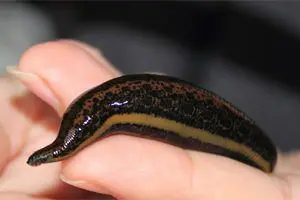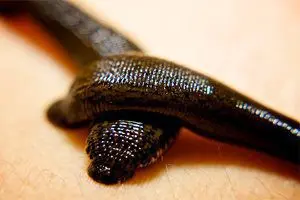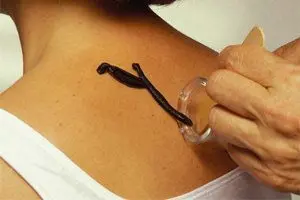Contents

The first mention of treatment with leeches dates back to the period of the third millennium BC. The procedure of hirudotherapy is depicted on ancient Egyptian frescoes, and later famous healers Hippocrates and Avicenna wrote about this technique in their writings. By the seventeenth century, hirudotherapy reached its peak of popularity in Old Europe: in those days, “bad blood” was considered the cause of all diseases, which had to be released with a scalpel or leeches.
Medical statistics say that between 1829 and 1836, 33 million leeches were used in France alone, and 7 million in England. By comparison, just over two million people lived on the British Peninsula at that time. Remarkably, the main supplier of leeches to Europe (about 70 million per year) was Russia with its huge pond farms.
Like any method of treatment, hirudotherapy must be used wisely, carefully and dosed, and private practitioners of the nineteenth century put leeches on their patients for any reason, sometimes up to two hundred at a time per patient, which led to the discrediting of hirudotherapy. Young specialists contemptuously dismissed this technique as a barbaric relic of the past. The leech boom is over, and with it the interest in medical leeches has gone, but only for the time being.
In 1884, the English physician John Haycraft discovered the enzyme hirudin in the saliva of leeches and described its therapeutic anticoagulant effect, and already in 1902 the first drugs based on hirudin appeared. And although by the beginning of the third millennium, mankind managed to thoroughly study the properties of leeches and develop synthetic analogues of almost all the useful substances that make up their saliva, the hirudotherapy procedure itself cannot be replaced by anything, and its benefits are enormous. That is why the treatment with leeches does not lose its relevance to this day.
The effect of hirudotherapy on the human body
Leeches attached to the body at the right points have the following types of therapeutic effects on the human body:
Reflexogenic In this sense, hirudotherapy is similar to acupuncture. Leeches sit on biologically active points associated with certain organs and systems, and they do it consciously. And biting through the skin and sucking out blood has a much more pronounced stimulating effect on the active point than setting needles according to the su-jok or zhen-jiu method;
Hemostatic – one leech sucks out from 5 to 10 ml of blood in one procedure, depending on the duration of the session and the size of the worm, moreover, bleeding from the wound continues for another 6-24 hours after removing the leech, since its injected substances interfere with blood clotting. Thus, there is an effective removal of congestion and unblocking of small vessels squeezed by edema and clogged with blood clots;
Decongestant – the leech enzyme hyaluronidase opens the drainage pathways and promotes active lymph flow in diseased tissues and organs, due to the breakdown of hyaluronic acid and resistance to human heparin. Thus, during the hirudotherapy procedure, the permeability of cell membranes is greatly increased and the deepest drainage effect is achieved;
Anticoagulant – another important leech enzyme, hirudin, normalizes blood clotting, resists the formation of blood clots, provides an anti-ischemic effect and promotes oxygenation of cells. But it is cellular hypoxia that is the main cause of all non-inflammatory pathologies, including oncology;
Immunostimulating – local influence is achieved due to the bacteria living in the digestive tract of leeches, which penetrates into the wound and causes an immune response in a person. The number of lymphocytes increases, macrophages are activated and the body’s defenses are strengthened;
Hypotensive – active lymph flow, elimination of edema, release of blocked vessels and capillaries, combined with an actual decrease in the amount of blood as a result of suction, leads to a natural decrease in blood pressure;
Anti-inflammatory – leeches not only help immune cells cope with microbes and bacteria, contributing to the synthesis of interleukins and removal of histohematological barriers, but also secrete into the blood substances similar in their action to antibiotics and destroy pathogens right in the focus, at the site of the leech;
Pain Reliever – the leech injects substances into the wound that act as a local analgesic, as well as increase the level of endorphin and reduce the level of bradykinin. Thus, hirudotherapy can help to cope with muscle, joint and headaches;
Anti-sclerotic – substances secreted by a leech accelerate the breakdown of fats, normalize the lipid balance of the blood and help reduce the level of LDL (“bad” cholesterol). Therefore, hirudotherapy is indicated for obesity and vascular atherosclerosis;
Regenerating – the hirudotherapy procedure activates the processes of cellular regeneration, which contributes to a speedy recovery after injuries of soft tissues and joints;
neurotrophic – the substances contained in the saliva of leeches maintain the viability of neurons, stimulate their development and activity, which means they help the brain work and strengthen the nervous system as a whole.
The saliva of medicinal leeches contains the following biologically active substances:
Hirudin;
Inhibitors of plasmin, trypsin, alpha-chymotrypsin, chimazine, elastase, subtilisin, cathepsin, kallikrinin, neutral proteases of granulocytes and blood coagulation factor 10;
Enzymes hyaluronidase, apyrase, destabilase, collagenase, cholesterolesterase, triglycerindase;
Prostanoids, antihistamines, analgesics and many others.
What leeches are used for hirudotherapy?

More than four hundred species of these annelids are found in nature: from the smallest, a few millimeters long, to huge forty-centimeter giants. But for medicinal purposes, only the medical leech (Hirudo medicinalis) and its three subspecies are used. They are grown in the laboratory and sold through the pharmacy chain.
Even if you are well versed in zoology, and are able to “recognize by sight” the right leech, you should not pretend to be Duremar from the fairy tale about Pinocchio and the Golden Key, and go to the pond with a net. Leeches living in nature are almost always full, because they need to be saturated only once every one and a half to two years, and they do not experience a shortage of victims. It is impossible to determine the degree of satiety by eye, therefore, most likely, you will have to keep “pets” for a couple of years before they agree to cling to you.
Indications for hirudotherapy
It is necessary to start treatment with leeches with an examination and consultation with a doctor, since this technique is far from always relevant, and has a number of contraindications. A qualified hirudotherapist, having your medical record and test results in hand, will be able to determine exactly whether leeches will help you, where, in what quantity and for how long to put them, how many sessions you need to conduct. Patients with serious illnesses or injuries are advised to undergo procedures in a hospital, under the supervision of a physician, since undesirable effects and complications may occur during the session.
But there are also such diseases in which treatment with leeches at home is allowed:
Hypertension, migraine, chronic headaches and menopausal hot flashes – leeches are placed vertically on the area of the mastoid processes behind the auricles, as far as possible from the nearby veins;
Thrombosis, thrombophlebitis and varicose veins – leeches are placed directly above the diseased vein or venous node, unless the skin in this place is too thin – then the leeches should be placed nearby, at a distance of 1 cm, on both sides of the diseased vein;
Local inflammatory processes, injuries, bruises, edema, hematomas – directly the focus of inflammation and around it;
Diseases of the liver and biliary tract – leeches are placed on the coccyx and in the right hypochondrium;
Kidney failure and nephritis – just above the waist;
Nail panaritium, furunculosis and other suppurations – next to the focus, on the most painful area.
It is possible to carry out home hirudotherapy procedures for alcoholism, loss of strength, chronic fatigue, as well as to speed up rehabilitation after injuries and operations, including those on the heart, but before that, a thorough examination and consultation with a doctor is required.
List of diseases that are more or less treatable with leeches:
Pulmonary ailments – bronchial asthma, chronic obstructive bronchitis, pleurisy, pneumonia, tuberculosis;
Skin lesions – psoriasis, neurodermatitis, eczema, alopecia, acne, rosacea, pyoderma, furunculosis;
Diseases of the cardiovascular system – angina pectoris, ischemia, hypertension, atherosclerosis, varicose veins, thrombophlebitis, vegetovascular dystonia;
Pathologies of the digestive tract – gastritis, gastroduodenitis, cholecystitis, pancreatitis, cirrhosis and fatty hepatosis of the liver, enterocolitis, stomach ulcer;
Diseases of the kidneys and urinary tract – pyelonephritis, urolithiasis, cystitis, chronic renal failure;
Female diseases – fibroids and erosion of the cervix, endometriosis, ovarian dysfunction and cysts, PMS and severe menopause, secondary infertility, obstruction of the fallopian tubes, adhesions in the pelvis, mastopathy;
Men’s diseases – chronic prostatitis, prostate adenoma, erectile dysfunction and impotence;
Endocrine diseases – diabetes mellitus, obesity, gout, thyroid cysts, disorders of the adrenal glands;
Neurological problems – sciatica, osteochondrosis, hernia of the spine and joints, paresis and paralysis, increased intracranial pressure, migraines, sleep disturbances;
Diseases of the ENT organs – Acoustic neuritis, sinusitis, chronic rhinitis and otitis;
Injuries – bruises, fractures, dislocations, hematomas;
Cosmetic defects – cellulite, wrinkles, acne, rosacea, skin laxity.
Hirudotherapy should not be considered as an independent and the only method of treatment – it is much more effective to combine treatment with leeches and acupuncture, physiotherapy, homeopathy and traditional drug therapy. Moreover, the effect of drugs can be significantly enhanced if you put a leech at the site of subcutaneous injection.
Treatment with leeches at home

Any person can carry out a home hirudotherapy procedure, there is nothing complicated about it. But before starting treatment, you need to consult a doctor and determine the exact number of leeches, the location and time of the session.
The hirudotherapy procedure consists of several stages:
Skin preparation. Wash the treatment area clean with baby soap and vigorously rub it with dry gauze until it turns slightly red to stimulate the appetite of leeches, and do not use cosmetics with strong odors for washing – this will repel them.
Setting up leeches. Take a leech with a clean vial or test tube and gently bring it with the front suction cup to the desired point. If the leech doesn’t want to bite, take another one, or try lubricating the skin with sweet water, or lightly pierce the skin with a sterile needle to bleed. When placing leeches on active points according to the method of hirudo-reflexotherapy, piercing is mandatory.
Hemorrhage process. At the moment of biting through the skin (1,5-2 mm deep), a slight burning sensation appears, which disappears after 10-20 seconds, as soon as analgesics from the salivary glands act. The leech is sucked on by both suction cups and stays on the skin on its own, so the bubble can be removed. If she is reluctant to suck out blood (wave-like movements are almost invisible on the body), you need to moisten your finger in warm water and gently stroke the leech from top to bottom on the back.
Completion of the procedure. After 30-60 minutes, the leech will be saturated and fall off by itself, but if, according to the indications, the patient needs a shorter session (15-25 minutes, less is pointless), the stuck leech should be removed. To do this, simply bring a cotton swab dipped in any aggressive-smelling liquid to the front suction cup – alcohol, vinegar, iodine, ammonia. If this does not help, you can fumigate the leech with cigarette smoke. It is absolutely impossible to pull, cut or pick it off – any violent actions make the leech only bite into the skin more strongly.
Period after the session. Within 6-24 hours, a small bleeding will continue from the wound, which has the shape of a three-rayed star. This is normal and even helpful. Just change sterile swabs or dressings. In no case do not disinfect or lubricate the bite site. A small scar will completely disappear in 2-3 weeks.
Disposal of leeches. Well-fed leeches must be destroyed by placing them in a container of chloramine. Even if they are not completely satiated, placing them on another patient after a few months can cause infection with those pathogens that were in the blood of the first patient (staphylococcus, tuberculosis, HIV, and many others).
On average, one treatment session takes from two to five leeches, less often ten. It is not recommended to put more than four pieces on the head area. Before starting the hirudotherapy procedure, subcutaneous injections of medicinal preparations can be made so that during the session their entry into the bloodstream and distribution throughout the body is accelerated. And after such a procedure, the blood sucked by leeches, and also they themselves can be used as a raw material for a medical mask.
How to properly contain leeches?
The very idea of keeping leeches at home looks dubious, because even if they are used to treat the same patient, they will have to wait at least a year and a half until they get hungry again. However, if the procedures have been performed regularly over the years, it is possible to keep several containers at home and mark them with the dates of the last use of the leeches.
All worries about keeping leeches are to change the water twice a week. Water should be clean, separated, as for aquarium fish. During the change and washing of the cans, you need to carefully review all the individuals in order to sort out the dead and sick, if any are suddenly found. Muddy water indicates the unhealthiness of leeches – even despite the presence of waste products of leeches in it, the water should normally be transparent.
Up to eighty individuals can fit in a liter jar, and up to two hundred in a three-liter jar. In the lid, you need to make several ventilation holes, but such that the leeches cannot crawl away. The best option is a fine, strong mesh. It is best to wrap the body of the jar with paper, and keep the leeches in a dark place with a comfortable, cool temperature.
Side effects and complications of hirudotherapy
Adverse reactions to leech treatment are rare, here is a list of possible complications:
Lymphadenitis – inflammation and enlargement of the lymph nodes, as a result of too active work. Usually they go away on their own in a couple of weeks, but if lymphadenitis is accompanied by fever and pain, you need to seek help from a doctor – you may need antibiotics;
Local allergic reactions – swelling, pain and itching in the area of staging leeches, wounds that do not heal for a long time. This side effect is easily relieved by taking antihistamines;
Common allergic reactions – rash, hives, shortness of breath, in severe cases – Quincke’s edema and anaphylactic shock. Urgent help is needed, and further treatment with leeches cannot be carried out;
Darkening of the skin and pronounced scars – sometimes the pigmentation of the skin changes at the site of the bite, then you have to resort to vacuum therapy or injections of autologous blood;
Prolonged bleeding – may indicate hemophilia – a violation of blood clotting. Such patients are not recommended to resort to hirudotherapy in the future;
Massive hematomas – are almost always the result of improper placement of leeches, too close to large veins.
Contraindications to hirudotherapy
There are diseases and conditions in which treatment with leeches is contraindicated:
Pregnancy;
Hemophilia;
Hypotension;
Asthenia;
Cachexia;
Iron deficiency anemia;
Tendency to allergic reactions and cases of Quincke’s edema or anaphylactic shock in history;
Acute infectious diseases accompanied by fever;
Severe immunodeficiency states, including AIDS;
Poisoning the body with poisons and heavy metals;
Some oncological diseases (consultation of an oncologist is required).









